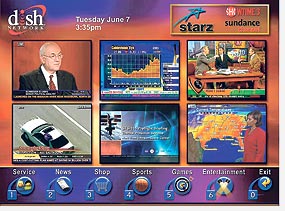 dotReader, “an open source, cross-platform content reader/management system with an extensible, plug-in architecture,” is available now in beta for Windows and Linux, and should be out for Mac any day now. For now, dotReader is just for reading but a content creation tool is promised for the very near future.
dotReader, “an open source, cross-platform content reader/management system with an extensible, plug-in architecture,” is available now in beta for Windows and Linux, and should be out for Mac any day now. For now, dotReader is just for reading but a content creation tool is promised for the very near future.
The reader has some nice features like shared bookmarks and annotations, a tab system for moving between multiple texts and an embedded web browser. In many ways it feels like a web browser that’s been customized for books. I can definitely see it someday becoming a fully web-based app. The recently released Firefox 2 has a bunch of new features like live bookmarks (live feed headlines in drop-down menus on your bookmarks toolbar) and a really nice embedded RSS reader. It’s a pretty good bet that online office suites, web browsers and standalone reading programs are all on the road to convergence.
Congrats to the OSoft team and to David Rothman of Teleread, who has worked with them on implementing the Open Reader standard in dotReader.
Category Archives: browser
the big picture
Though a substantial portion of our reading now takes place online, we still chafe against the electronic page, in part because today’s screens are hostile to the eye, but also, I think, because we are waiting for something new – something beyond a shallow mimicry of print. Occasionally, however, you come across something that suggests a new possibility for what a page, or series of pages, can be when words move to the screen.
I came across such a thing today on CNET’s new site, which has a feature called “The Big Picture,” a dynamic graphical display that places articles at the center of a constellation, drawing connections to related pieces, themes, and company profiles.

Click on another document in the cluster and the items re-arrange around a new center, and so on – ontologies are traced. But CNET’s feature does not go terribly far in illuminating the connections, or rather the different kinds of connections, between articles and ideas. They should consider degrees of relevance, proximity in time, or overlaps in classification. Combined with a tagging system, this could get interesting. As it stands, it doesn’t do much that a simple bullet list of related articles can’t already do admirably, albeit with fewer bells and whistles.
But this is pushing in an interesting direction, testing ways in which a web publication can organize and weave together content, shedding certain holdovers from print that are no longer useful in digital space. CNET should keep playing with this idea of an article ontology viewer – it could be refined into a legitimately useful tool.
convergence sighting: the multi-channel tv screen

Several new “interactive television” services are soon to arrive that offer “mosaic” views of multiple channels, drawing TV ever nearer to full adoption of the browser, windows, and aggregator paradigms of the web (more in WSJ). It seems that once television is sufficiently like the web, it will simply be the web, or one province thereof.
